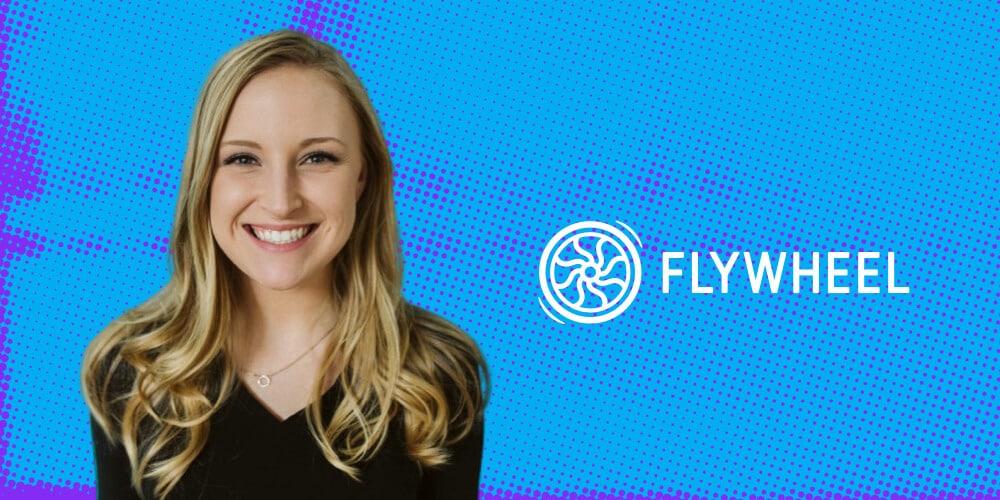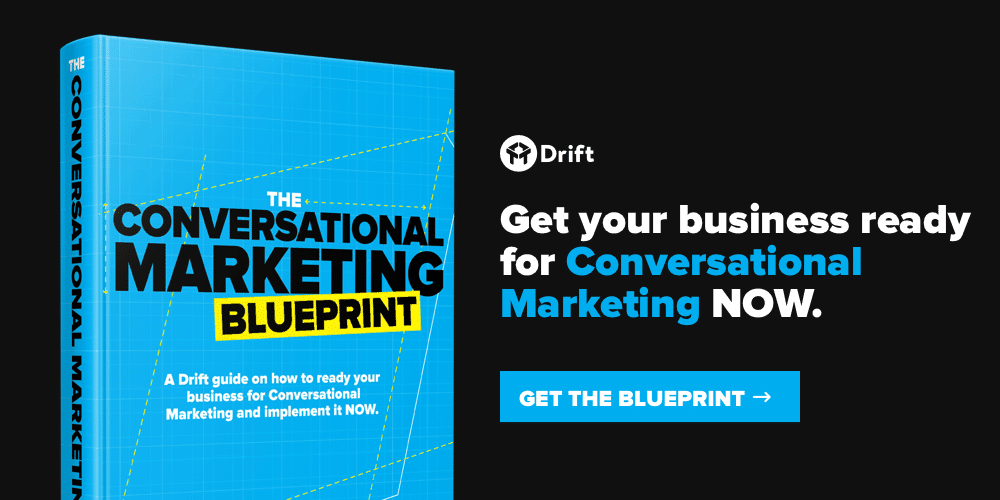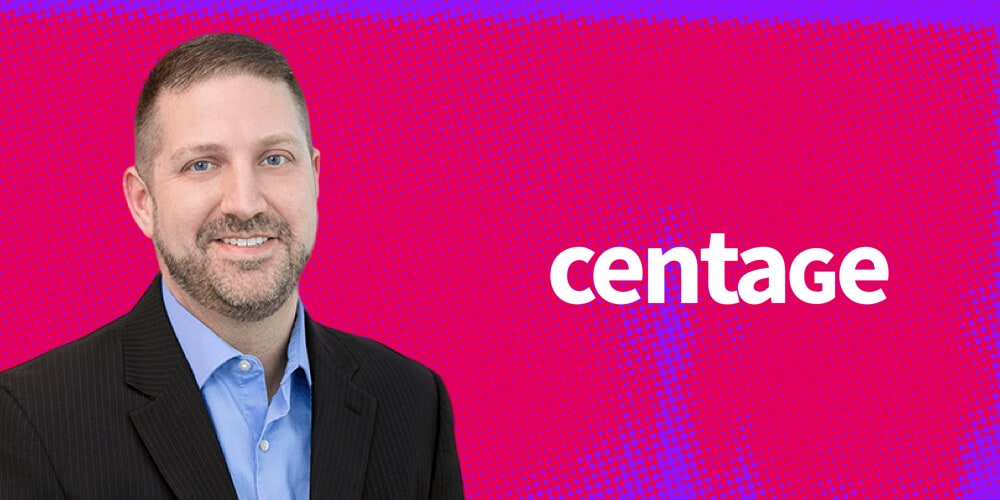
You don’t often come across a technology company that uses words like “delightful” and “thoughtful,” but that’s exactly the kind of language you’ll see on the Flywheel homepage.
Our brand personality and voice are very important to us from a messaging standpoint. We truly believe it embodies the company we’ve built and how we want to engage our customers. Flywheel is a managed WordPress hosting platform, and we’ve created a beautiful dashboard stacked with tools and features that help creatives do their best work and streamline their workflow. Combined with our fuss-free local development application, we’ve helped more than 100,000 people scale their businesses on WordPress.
The four pillars of our brand voice are whimsical, intentional, human, and vibrant; so it only makes sense that we would adopt a conversational approach to our marketing. For a year, we’ve been using Drift to deliver a better experience on our website, whether a visitor needs a recommendation on content, wants to contact support, or is ready for a sales conversation.
Drift helps visitors quickly navigate our website and easily access the information they need. It’s also a powerful sales enablement tool that helps us generate qualified conversations that have become an intrinsic part of how we’re creating new leads.
Our Big-Picture Philosophy About Conversations
We’re on a mission to humanize hosting, so we aim to use Drift in a way that’s, well, human! There were initial conversations on whether a chatbot could truly be a quality, human interaction, but we’ve seen great success thanks to an adaptive strategy that includes your sales team as a stakeholder, as well as your prospects and customers.
Our approach to Drift focuses on delivering a better customer experience that provides tangible value to the customer. It’s not just about enabling sales and improving landing page conversions; it’s about making people fall in love with our brand and our products. Drift conversations give us an organic opportunity to share our brand voice, product knowledge, wealth of resources, and thought leadership. It’s also a way for us to help guide the user’s journey as they get to know Flywheel.
No matter where they are in their customer journey, our job number one is always providing value to the user by solving their problem. They might be meeting us for the first time, or are customers we’ve had for years. Either way, we want to be able to tailor playbooks and messaging based on the nature of the relationship and the context of the conversation. We’ve seen that if we focus on providing value first and foremost, it establishes trust with users and creates immense brand loyalty among customers.
Our approach is constantly evolving, but one of its hallmarks is the use of page-specific playbooks that are designed to engage users based on how people usually interact on that page. Variations might include welcome messages, return-visitor messages, and specific conversational and informational content appropriate to the page.
Our goal is to ensure each playbook is relevant not only to the page goals, but also to the user’s goal or experience on that page. We want each Drift conversation to assist the customer on their journey. For this reason, each of our playbooks is built around learning as much as we can about the person so we get them what they need as quickly and easily as possible. And in certain cases, we also tailor playbooks to specific audiences. For example, people visiting a page for the first time versus the fifth time would see different, personalized messages.
In addition, we pay special attention to creating continuity by ensuring that our playbooks are an extension of the content on a given page and that the conversations are then an extension of the playbook. It should all blend together to deliver a cohesive experience that makes sense and helps users accomplish their goals.
Tracking & Measuring
When we first started using Drift, we broke it out as its own channel, but soon realized that it was more effective to blend Drift leads into the broader lead funnel. Since Drift is, in essence, just another channel we use to qualify a lead, we wanted to incorporate it with all other channels, similar to how an SDR (Sales Development Representative) qualifies a lead via a phone call. With this approach, Drift assists in all our lead bucket goals (number of leads, MQLs, SQLs, etc.).
To ensure that we’re always able to evolve our strategy and tactics, I track a number of things:
- I have a detailed Google report that tracks the pages where we use Drift and how those pageviews compare to the number of conversations on those pages.
- I pull all kinds of conversations to identify topics and trends that can be used to optimize our playbooks.
- I pay a lot of attention to comparing bot-only to bot+human conversations to see where each tactic is raising engagement and how we can apply insights about engagement and specific messaging and language to help our sales team.
- I’m also starting to look at the send-to-conversation rates of certain playbooks based on individual page goals and audiences. It’s important to measure success based on context.
Conversation Workflow & Opportunities
Our Drift workflow puts SDRs in charge of qualifying conversations and then routing appropriate conversations to account executives, senior account executives, or expansion account managers based on what we’ve learned in the course of the conversation. SDRs are able to filter users to the right place, whether that’s getting them to a specific piece of information on the website, sharing relevant resources, handing them off to support, capturing the lead, or putting them in touch with the right salesperson.
This flow covers both chat and qualifying bots that we deploy based on how a specific page or audience fits into our sales/marketing funnel. The specific chatbot or playbook a visitor sees depends on context, i.e. the page they’re visiting, how many times they’ve visited our site, etc.
I also compare tags applied to conversations by our chat team. At a high-level, this helps us get a sense of who the users are, what they’re engaged with, and the most common topics of conversation. Then, I compare tag trends on pages and playbooks to optimize our content and conversion rates. This helps us make sure our messaging is sticking with the users, we’re providing value, and the user is getting the information they need.
For example, if someone is on the pricing page, they could be anywhere in the funnel. So we’d likely try to identify where they are so we can tailor the conversation accordingly. However, from looking at trends on our homepage, we decided not to fire a playbook to capture more information because we know they are most likely on the page to log in to our app or view pricing. We decided to let those conversations happen organically where the user would find them most relevant.
Overall, my strategy is to identify the biggest opportunities on our website by looking at the pages that get the most traffic with lower conversion rates. If we know people are going to these pages but not moving forward in the buyer journey, I want to be sure they have something to interact with or a way to find the resources they were looking for. This means really dissecting what the user is trying to do on the page, what we want them to do, and making sure we’re not competing with an existing CTA by introducing a Drift playbook.
Luckily, Drift is really flexible in terms of how its designed and deployed, so we’re able to customize how we use it based on our users’ needs and our business objectives. And we keep the widget persistent across the site, so it’s always there if a visitor wants to ask us a question or start a chat.
The Power of Voice, Tone, & Personality
Tone of voice is really, really important to us. There is so much value behind our brand and the way it resonates with our audience. This is a hard-earned asset that we want to nurture and protect.
To ensure that we were able to integrate Drift in a way that is authentic to our brand, I run trainings for any Flywheeler who’ll be using Drift. The primary message of this training is to drive home that our main goal is to always be delivering value to the customer, no matter where they are in their journey.
Beyond that, we use style guides and brand voice guides that define everything from proper grammar to conversation styles. For instance, we encourage our SDRs to remember that the conversation is happening on chat. This means that writing out long paragraphs isn’t the best approach if you think about the small space where the user is seeing that message. That’s not what the customer expects (or wants). On the other hand, we want to be sure that SDRs maintain a certain level of professionalism.
One of the really helpful rules of thumb we rely on is to match the style of the person on the other end of the chat. If they are joking around and sending gifs, it’s totally fine for our SDRs to match that tone. Basically, it’s all about listening, sticking to brand guidelines, and following the everything-in-moderation rule.
Another tactic that we use in our bots is to almost always ask open-ended questions. These types of questions help keep the conversation going, whether they are introduced at the beginning of the conversation or used at the end of a playbook while the bot is routing the customer to a member of the sales team.
For example, asking things like, “What can we help you with?” or “Which hosting plan is catching your eye?” invites the customer to think about what they might want to know. Similarly, we can interject a closing line while routing to a Flywheeler to help nudge additional dialogue: “Sounds good! We’ll grab a Flywheeler to help you out. In the meantime, what other questions do you have?” A yes/no question, on the other hand, (like “Do you have any questions?”) makes it too easy for the customer to shut the conversation down, meaning they’re not actively thinking about how Flywheel fits into their workflow. We want to keep the conversation rolling and get them thinking about what solutions Flywheel can offer!
A World Of Possibilities
Drift is helping us engage with our customers in a way that is more human (like our hosting services) and also more effective for both users and our business. Being able to create customized conversations that incorporate our brand voice and personality with our sales and marketing objectives gives us an amazingly broad palette to work with. We’re able to build on the brand equity we’ve already earned in an aligned and authentic way.
Looking ahead, we’ll continue measuring, optimizing, and exploring new strategies and tactics on optimizing Drift for our users and brand. The reception so far has been very positive, and we only imagine it’ll get better from here!
Ready to learn more about conversational marketing? This guide will give you everything you need to know to set you (and your company) up for success.
Brittany is part of Flywheel’s growth marketing team. She creates all of Flywheel’s Drift playbooks and contributes to their chatbot strategy. In addition to all things Drift, she also focuses on conversion writing, sales enablement content, and lead nurturing.
Editor’s Note: This is a guest post. Interested in contributing content to the Drift blog? Email Molly Sloan at msloan@drift.com.






